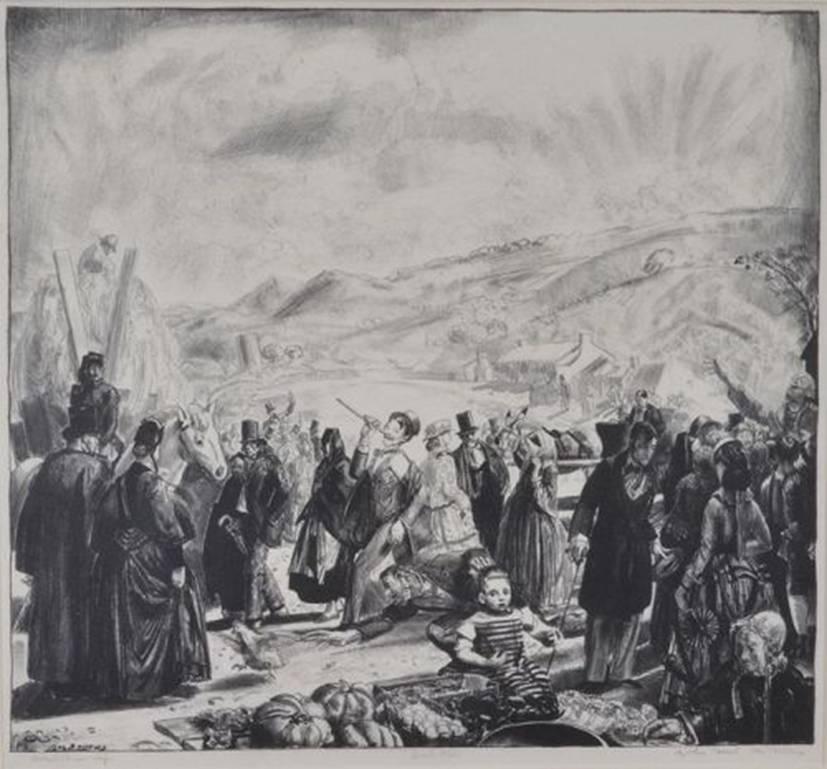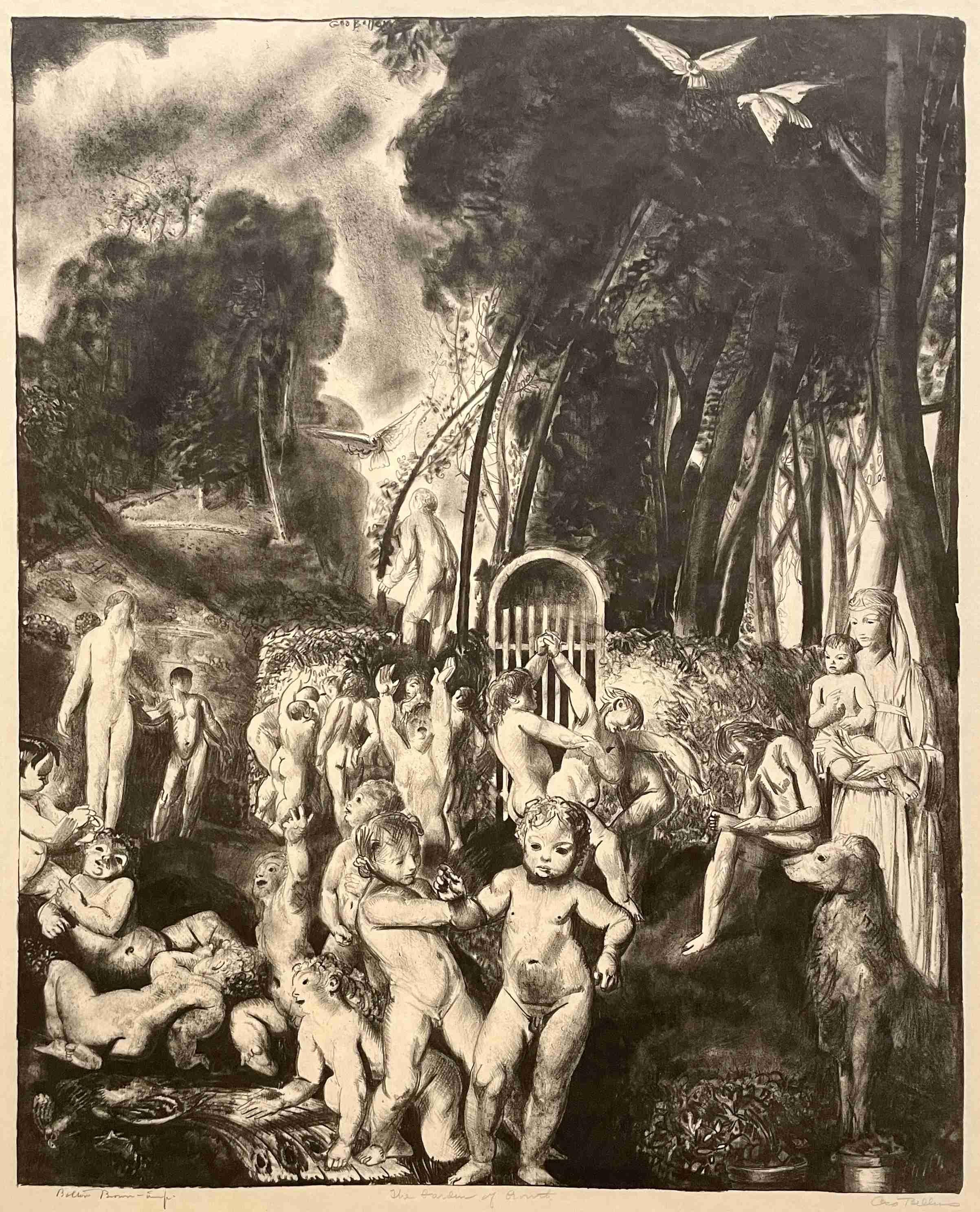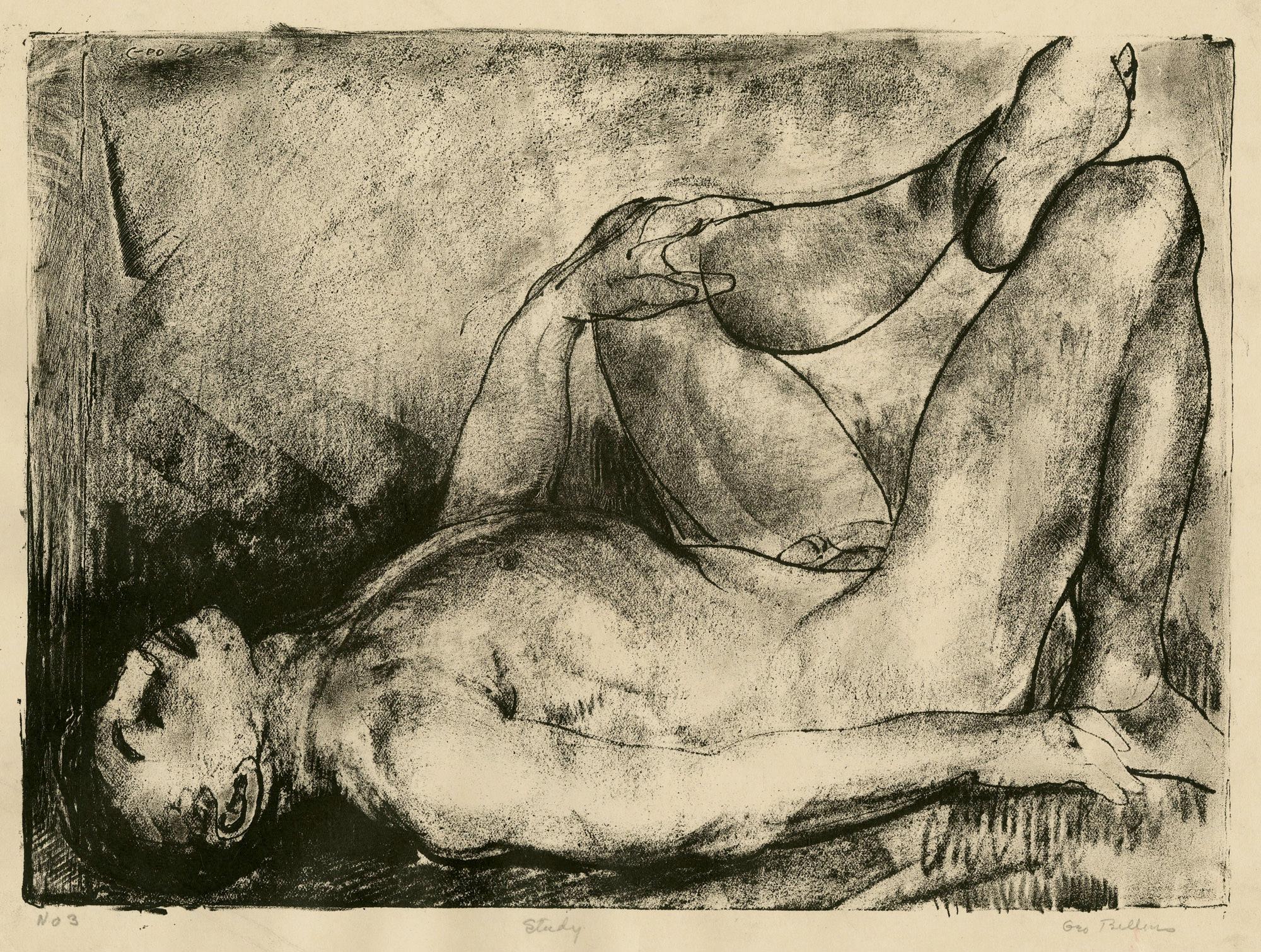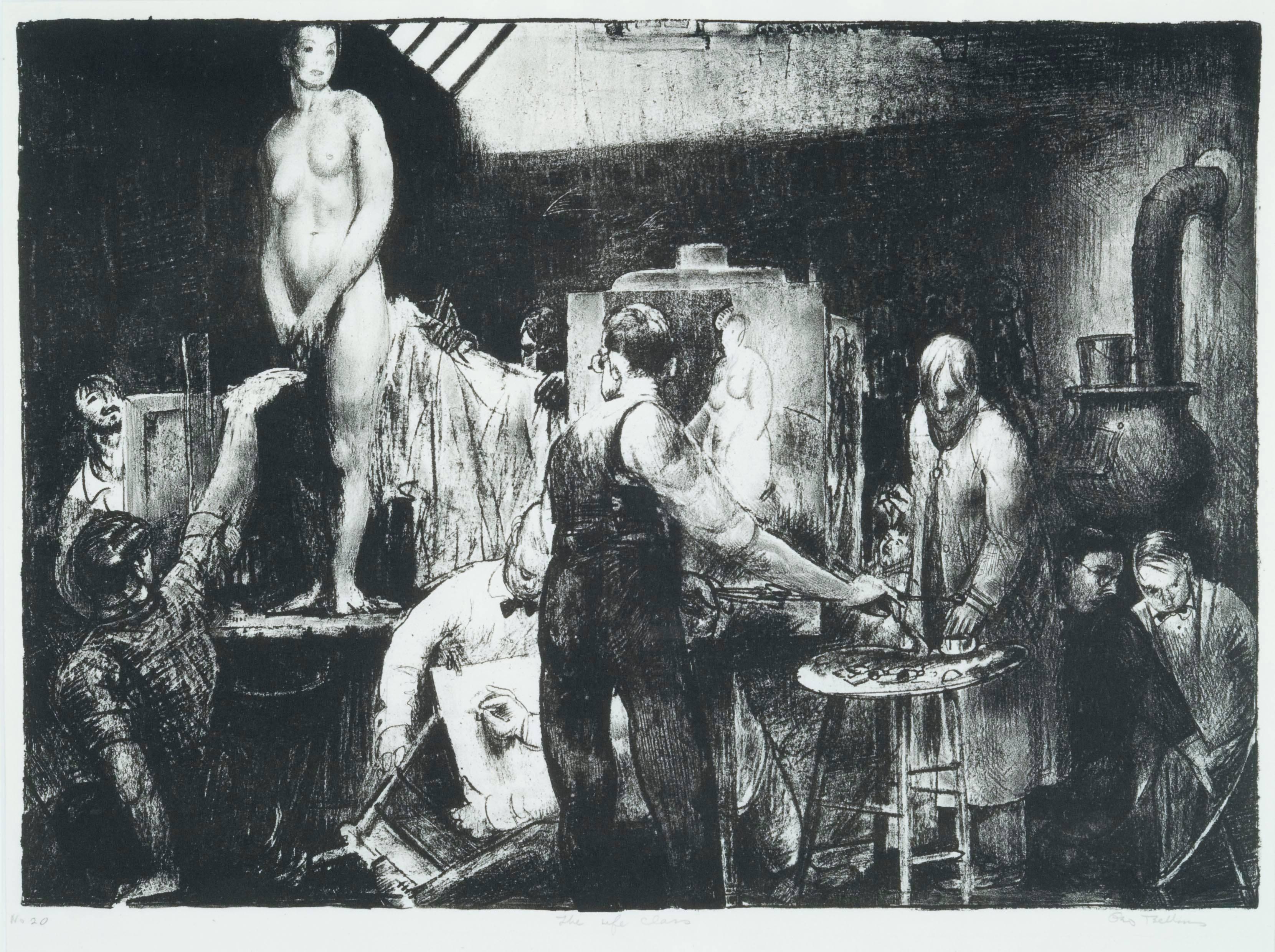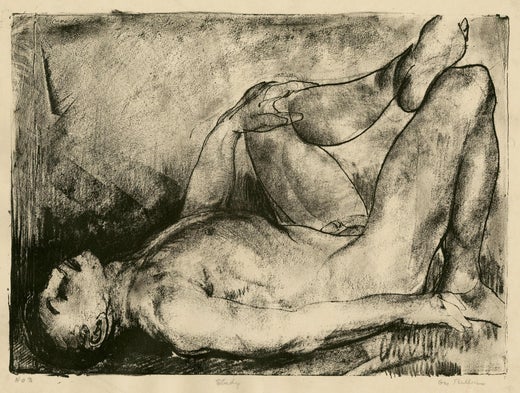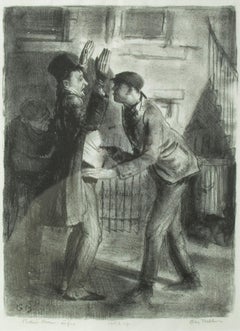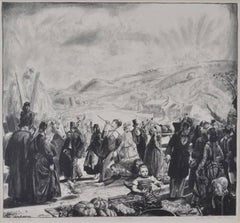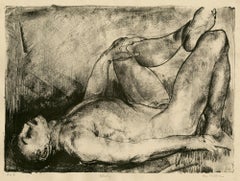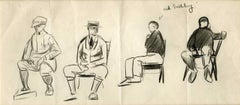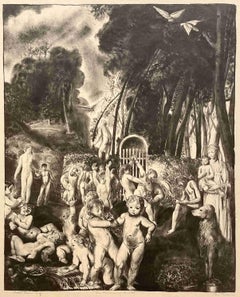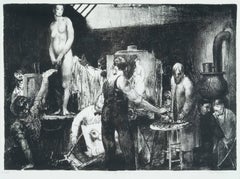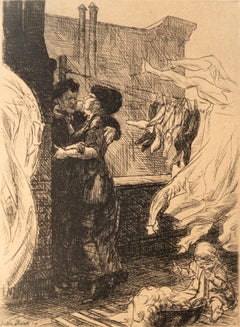Items Similar to The Mouth of Honey
Want more images or videos?
Request additional images or videos from the seller
1 of 11
George Wesley BellowsThe Mouth of Honey1922
1922
$55,000
£41,475.46
€47,968.36
CA$77,164.71
A$85,773.37
CHF 44,960.56
MX$1,047,500.32
NOK 561,306.64
SEK 528,084.84
DKK 358,021.90
About the Item
The Mouth of Honey
Lithographic crayon and mixed media on paper mounted to support paper
Initialed by the artist "GB" bottom center on image. (see photo)
Titled in pencil in bottom margin. (see photo)
Mounted to support by the artist. Titled by the artist on the support mount.
This is the drawing illustration that was used in Century Magazine, June 1922..
A copy of the issue of Century Magazine accompanies the drawing.
From Donn Byrne's novel "The Wind Bloweth," as published in "The Century Magazine" Volume 104, no. 2 (June, 1922), p. 249. "The Mouth of Honey" is Part III of the novel, and the third installment as serialized in the magazine. Unlike some of the other illustrations Bellows did for "The Wind Bloweth," this drawing was not made into a print, and remains unique.
Provenance: Their original 1922 price of $100.00 in pencil on mount, lower left corner recto from Keppel and Company, NY.
The Wind Bloweth, page 135
"Their hands touched, and there seemed to rush between them, through them, some powerrful current: and how it happened he did not know, but they were kissing each other..."
The larger version of this image was exhibited at the Museum of Arts and Sciences, Macon, Georgia, listed as Private Collection
It was later purchased by Mary Lublin Fine Arts, New York and offered at $185,000.
The image of the larger version measures 18 x 16 1/2 inches
- Creator:George Wesley Bellows (1882-1925, American)
- Creation Year:1922
- Dimensions:Height: 10.875 in (27.63 cm)Width: 9.625 in (24.45 cm)
- Medium:
- Movement & Style:
- Period:
- Condition:Mounted to support by the artist.
- Gallery Location:Fairlawn, OH
- Reference Number:Seller: FA78811stDibs: LU14010991732
George Wesley Bellows
George Bellows, an American artist, was born in Columbus, Ohio in 1882, the only child of a successful building contractor from Sag Harbor, New York. He entered Ohio State University in 1901, where he played baseball and basketball and made drawings for college publications. He dropped out of college in 1904, went to New York, and studied under Robert Henri (American, 1865 – 1929) at the New York School of Art, where Edward Hopper (American, 1882 – 1967), Rockwell Kent (American, 1882 – 1971), and Guy Pène du Bois (American, 1884 – 1958) were his classmates. A superb technician who worked in a confident, painterly style, Bellows soon established himself as the most important realist of his generation. He created memorable images of club fights, street urchins swimming in the East River, and the Pennsylvania Station excavation site and garnered praise from both progressive and conservative critics. In 1910 Bellows began teaching at the Art Students League and married Emma Story, by whom he had two daughters. After 1910 Bellows gradually abandoned the stark urban realism and dark palette characteristic of his early work and gravitated toward painting landscapes, seascapes, and portraits. Bellows helped organize the Armory Show in 1913, in which five of his paintings and a number of drawings were included. That year he was elected a full member of the National Academy of Design. He had leftist political views and contributed illustrations to the Socialist publication The Masses from 1912 to 1917. Bellows began to make lithographs in 1916 and his exceptional talent engendered a revival of interest in the medium. He worked in Maine, in Carmel, California, and in Middletown, Rhode Island, and was a founding member of the Society of Independent Artists and a charter member of the Association of American Painters and Sculptors. In 1919 he taught at the Art Institute of Chicago. Bellows, who never went to Europe, is regarded as a quintessential American artist whose vigorous style enabled him to explore a wide range of subjects from scenes of modern urban life to portraits of his daughters, to turbulent Maine seascapes. As an early biographer noted, Bellows “caught the brute force of the prizefighter, the ruggedness of the country pasture, the essence of childhood and recorded them appropriately not only for his own generation but for all time.”[1] [1] [Frederick A. Sweet], George Bellows: Paintings, Drawings and Prints (Art Institute of Chicago, IL, 1946). Robert Torchia September 29, 2016
About the Seller
5.0
Recognized Seller
These prestigious sellers are industry leaders and represent the highest echelon for item quality and design.
Platinum Seller
Premium sellers with a 4.7+ rating and 24-hour response times
Established in 1978
1stDibs seller since 2013
808 sales on 1stDibs
Typical response time: <1 hour
Associations
International Fine Print Dealers Association
- ShippingRetrieving quote...Shipping from: Fairlawn , OH
- Return Policy
Authenticity Guarantee
In the unlikely event there’s an issue with an item’s authenticity, contact us within 1 year for a full refund. DetailsMoney-Back Guarantee
If your item is not as described, is damaged in transit, or does not arrive, contact us within 7 days for a full refund. Details24-Hour Cancellation
You have a 24-hour grace period in which to reconsider your purchase, with no questions asked.Vetted Professional Sellers
Our world-class sellers must adhere to strict standards for service and quality, maintaining the integrity of our listings.Price-Match Guarantee
If you find that a seller listed the same item for a lower price elsewhere, we’ll match it.Trusted Global Delivery
Our best-in-class carrier network provides specialized shipping options worldwide, including custom delivery.More From This Seller
View AllThe Hold Up, First State
By George Wesley Bellows
Located in Fairlawn, OH
Signed in pencil by the artist lower right
Titled "Hold Up" by the artist in pencil.
Signed by the printer Bolton Brown lower left.
Edition: 42 in this state
Note: In The Hold Up, se...
Category
1920s American Realist Figurative Prints
Materials
Lithograph
The Irish Fair
By George Wesley Bellows
Located in Fairlawn, OH
Irish Fair
Lithograph, 1923
Signed and numbered in pencil by the artist (see photo)
Titled "Irish Fair" by the artist in pencil
Edition: 84
Housed in an archival frame with acid free matting (see photo)
Provenance:
Estate of the artist, Bellows Family Trust
H.V. Allison & Company (label)
Private Collection, Columbus
References And Exhibitions:
Reference: Mason 153
Note: An illustration commissioned by The Century Company for Don Byrne's novel The Wind Bloweth
Image: 18 7/8 x 21 3/8"
Frame: 29 1/2 x 30 1/2"
“Eleven on a hot July morning, and the little town...
Category
1920s Ashcan School Figurative Prints
Materials
Lithograph
Man on His Back, Nude
By George Wesley Bellows
Located in Fairlawn, OH
Man on His Back, Nude
Lithograph, c. 1916
Signed by the artist lower right: Geo Bellows (see photo)
Annotated bottom left: No. 3 by the artist (see photo)
An unredorded trial proof b...
Category
1910s Ashcan School Nude Prints
Materials
Lithograph
red ballboy or Studies for "Tennis Tournament"
By George Wesley Bellows
Located in Fairlawn, OH
Red Ballboy or Studies for "Tennis Tournament"
Crayon on paper, c. 1920
Unsigned
Condition: three vertical folds created by the artist to transport the drawing from the tennis match ...
Category
1910s Ashcan School Figurative Drawings and Watercolors
Materials
Graphite
Man, Wife and Child
By John French Sloan
Located in Fairlawn, OH
Man, Wife and Child
Etching, 1905
Signed and titled in pencil by the artist below image (see photo)
Annotated in pencil by the artist "100 proofs"
Signed and dated in the plate lower...
Category
Early 1900s Ashcan School Figurative Prints
Materials
Etching
"And wasn't it good for a boy to be Out to old Aunt Mary's"
By Howard Chandler Christy
Located in Fairlawn, OH
"And wasn't it good for a boy to be Out to old Aunt Mary's"
Charcoal and watercolor on artist illustration board, 1900
Initialed and dated lower right: H.C.C. 1900 by the artist (see...
Category
Early 1900s American Impressionist Figurative Drawings and Watercolors
Materials
Charcoal
You May Also Like
The Green Hour (or Angna Enters in “The Green Hour”)
By John Sloan
Located in New York, NY
John Sloan (1871-1954), The Green Hour (or Angna Enters in “The Green Hour”), etching, 1930, signed in pencil lower right, inscribed “100 proofs” lower le...
Category
1930s American Realist Portrait Prints
Materials
Etching
1923 George Bellows Lithograph, Titled "The Garden of Growth'
Located in Chicago, IL
A 1923 lithograph on paper by George Bellows, titled The Garden of Growth, from the “Men Like Gods” Series. Artwork size: 18" x 14 1/2". Archivally matted to 23 3/4" x 17 3/4".
...
Category
1920s Art Deco Figurative Prints
Materials
Lithograph, Paper
THE LIFE CLASS - SECOND STONE (THE MODEL, LIFE CLASS).
By George Wesley Bellows
Located in Portland, ME
Bellows, George. THE LIFE CLASS - SECOND STONE (THE MODEL, LIFE
CLASS). Mason 43, Bellows 193. Lithograph, 1917. Edition of 49,
signed by Bellows. Inscribed "No.20," titled and sign...
Category
Early 20th Century Figurative Prints
Materials
Lithograph
"Love on the Roof" American Realist Etching
By John Sloan
Located in Austin, TX
By John Sloan
American Realist
From the early 20th century Ashcan School which focused on capturing day to day life in New York City during that period.
Image size: 5.75" x 4.25"
Et...
Category
Early 20th Century American Realist Figurative Prints
Materials
Archival Paper, Etching
New Year’s Eve and Adam
By John Sloan
Located in Myrtle Beach, SC
John Sloan, 'New Year's Eve and Adam', etching, 1918, edition 100, (only 85 printed), Morse 190. Signed, titled and annotated '100 proofs' in pencil. Signed and dated in the plate, l...
Category
1910s Ashcan School Figurative Prints
Materials
Etching
By the Fire
By Everett Shinn
Located in Fort Washington, PA
Medium: Charcoal on Paper
Signature: Signed Lower Left
Category
Early 1900s Interior Drawings and Watercolors
Materials
Paper, Charcoal
More Ways To Browse
Ashcan New York
George Bellows Artists
Antique Bellows
George Byrne
Watercolour Painting
Vintage Art Drawings
Figurative Watercolour
Original Watercolors
Original Watercolor Painting
Watercolor Paintings In Landscapes In Watercolor
Framed And Signed Watercolors
Art Brown Drawings
Abstract Watercolour Art
Abstract Watercolour Paintings
Drawings Vintage Frame
American Watercolours
Antique Watercolours
Watercolor Brown

